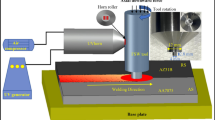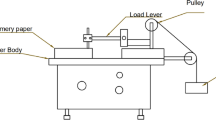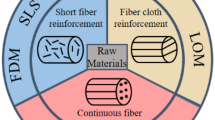Abstract
One of the most important factors negatively affecting the efficiency of a robot arm is excessive weight. Therefore, the present work is focused on the application of polymer-metal composite instead of monolithic aluminum (Al) beam for high free vibration performance with lightweight. Vibration behavior of the robot arm with a scarf joint configuration is evaluated through the experimental and simulation results. Moreover, mechanical properties and interface morphology of the hybrid beam (HB) are investigated. Scanning electron microscope (SEM) analysis of the fracture surfaces is also performed after the tensile-shear testing. According to the experimental results, it is observed that the natural frequency and damping ratio are improved for the HB compared to the monolithic aluminum by 21.36% and 150%, respectively. Furthermore, the obtained simulation results are in tight agreement with the experimental findings. After the parametric study performed, it is discovered that the ratio of aluminum component in the hybrid robot arm should be 70.45% for the maximum frequency. The physicochemical variation on the metallic adherend after the laser ablation and accordingly the formation of more favorable conditions is proved for the Al-PA66 composite direct bonding. An average failure load of 2844 N is achieved, and it has been realized that the post-tensile fractured surfaces demonstrate a combined failure mode as the cohesive with composite adherend failure. The overall results show that a higher natural frequency and damping ratio, accompanied by favorable mechanical properties, can be achieved for the HB produced through direct bonding in the scarf configuration.

















Similar content being viewed by others
Data Availability
The raw/processed data used herein to justify these findings can be shared upon reasonable request. Interested researchers can directly contact the corresponding author.
References
Krimpenis, A.A.; Papapaschos, V.; Bontarenko, E.: HydraX, a 3D printed robotic arm for hybrid manufacturing. Part I: Custom design manufacturing and assembly. Procedia Manuf. 51, 103–108 (2020). https://doi.org/10.1016/j.promfg.2020.10.016
Yin, H.; Liu, J.; Yang, F.: Hybrid structure design of lightweight robotic arms based on carbon fiber reinforced plastic and aluminum alloy. IEEE Access (2019). https://doi.org/10.1109/ACCESS.2019.2915363
Moazed, R.; Khozeimeh, M.A.; Fotouhi, R.: Simplified approach for parameter selection and analysis of carbon and glass fiber reinforced composite beams. J. Compos. Sci. (2021). https://doi.org/10.3390/jcs5080220
Möhring, H.C.: Composites in production machines. Procedia CIRP (2017). https://doi.org/10.1016/j.procir.2017.04.013
Duraisamy, P.; Kumar Sidharthan, R.; Nagarajan Santhanakrishnan, M.: Design, modeling, and control of biomimetic fish robot: a review. J. Bionic Eng. (2019). https://doi.org/10.1007/s42235-019-0111-7
Che, J.-L.; Kim, J.-H.; Lee, H.-S.; Chang, S.-H.: Application of carbon/epoxy composites to robot console structure for high stiffness with lightweight. Compos. Struct. (2022). https://doi.org/10.1016/j.compstruct.2022.116121
Möhring, H.-C.; Brecher, C.; Abele, E.; Fleischer, J.; Bleicher, F.: Materials in machine tool structures. CIRP Ann. (2015). https://doi.org/10.1016/j.cirp.2015.05.005
Kato, M.; Kono, D.; Kakinuma, Y.: Dynamical characteristic validation of motorized CFRP spindle unit based on receptance coupling. Mech. Syst. Signal Process. (2022). https://doi.org/10.1016/j.ymssp.2022.109028
Liu, X.; Zhu, H.; Xie, Y.; Xu, L.; Lin, N.; Lu, L.: Optimization of microstructural morphology via laser processing to enhance the bond strength of Al-CFRP. J. Reinf. Plast. Compos. (2021). https://doi.org/10.1177/0731684420973066
Min, J.; Wan, H.; Carlson, B.E.; Lin, J.; Sun, C.: Application of laser ablation in adhesive bonding of metallic materials: a review. Opt. Laser Technol. (2020). https://doi.org/10.1016/j.optlastec.2020.106188
Huang, Y.; Gao, X.; Zhang, Y.; Ma, B.: Laser joining technology of polymer-metal hybrid structures—a review. J. Manuf. Process. (2022). https://doi.org/10.1016/j.jmapro.2022.05.026
Dong, H.; Tang, Z.; Li, P.; Wu, B.; Hao, X.; Ma, C.: Friction stir spot welding of 5052 aluminum alloy to carbon fiber reinforced polyether ether ketone composites. Mater. Des. (2021). https://doi.org/10.1016/j.matdes.2021.109495
Jiao, J.; Jia, S.; Xu, Z.; Ye, Y.; Sheng, L.; Zhang, W.: Laser direct joining of CFRTP and aluminium alloy with a hybrid surface pre-treating method. Compos. B Eng. (2019). https://doi.org/10.1016/j.compositesb.2019.106911
Wannapa, N.; Uthaisangsuk, V.: Experimental and numerical failure analyses of dissimilar material joints between aluminium and thermoplastic. Compos. Struct. (2020). https://doi.org/10.1016/j.compstruct.2020.112762
Huang, H.; Sun, M.; Wei, X.; Sakai, E.; Qiu, J.: Effect of interfacial nanostructures on shear strength of Al-PPS joints fabricated via injection moulding method combined with anodising. Surf. Coat. Technol. (2021). https://doi.org/10.1016/j.surfcoat.2021.127896
Liao, W.; Zhao, S.; Gao, M.: Oscillating laser conduction joining of dissimilar PET to stainless steel. Polymers (2022). https://doi.org/10.3390/polym14224956
Zhou, Y.; Ning, F.: Joining CFRP/Ti stacks by directed energy deposition: surface topography effects on interface formation and bonding. Compos. B Eng. (2022). https://doi.org/10.1016/j.compositesb.2022.110365
Shiravi, H.; Movahedi, M.; Ozlati, A.: Improving appearance and mechanical strength of aluminum-polypropylene/talc composite friction stir joint using a novel tool design. Int. J. Adv. Manuf. Technol. (2022). https://doi.org/10.1007/s00170-022-09581-7
Zhang, Y.; Yang, Y.; Hu, J.; Luo, Z.; Bi, J.; Li, Y.; Su, J.: Microstructure and joining mechanism of Al/CFRTP resistance element welded joints. J. Manuf. Process. (2022). https://doi.org/10.1016/j.jmapro.2022.10.014
Ota, H.; Jespersen, K.M.; Saito, K.; Wada, K.; Okamoto, K.; Hosoi, A.; Kawada, H.: Effect of the interfacial nanostructure on the interlaminar fracture toughness and damage mechanisms of directly bonded carbon fiber reinforced thermoplastics and aluminum. Compos. A Appl. Sci. Manuf. (2020). https://doi.org/10.1016/j.compositesa.2020.106101
Abe, H.; Chung, J.C.; Mori, T.; Hosoi, A.; Jespersen, K.M.; Kawada, H.: The effect of nanospike structures on direct bonding strength properties between aluminum and carbon fiber reinforced thermoplastics. Compos. B Eng. (2019). https://doi.org/10.1016/j.compositesb.2019.05.025
Iwata, K.; Suzuki, A.; Kim, S.-G.; Takata, N.; Kobashi, M.: Enhancing the solid-state joinability of A5052 and CFRTP via an additively manufactured micro-structure. J. Mater. Process. Technol. (2022). https://doi.org/10.1016/j.jmatprotec.2022.117629
Hernandez, E.; Alfano, M.; Lubineau, G.; Buttner, U.: Improving adhesion of copper/epoxy joints by pulsed laser ablation. Int. J. Adhes. Adhes. (2016). https://doi.org/10.1016/j.ijadhadh.2015.10.003
Wan, H.; Min, J.; Lin, J.: Experimental and theoretical studies on laser treatment strategies for improving shear bonding strength of structural adhesive joints with cast aluminum. Compos. Struct. (2022). https://doi.org/10.1016/j.compstruct.2021.114831
Feng, Z.; Zhao, H.; Tan, C.; Zhu, B.; Xia, F.; Wang, Q.; Chen, B.; Song, X.: Effect of laser texturing on the surface characteristics and bonding property of 30CrMnSiA steel adhesive joints. J. Manuf. Process. (2019). https://doi.org/10.1016/j.jmapro.2019.09.046
Won, S.J.; Kim, H.S.: Effects of laser parameters on morphological change and surface properties of aluminum alloy in masked laser surface texturing. J. Manuf. Process. (2019). https://doi.org/10.1016/j.jmapro.2019.10.034
Darla, V.; Satish Ben, B.; Sai Srinadh, K.; Venkata, R.K.: Evaluation of aluminum to composite bonded lap joints. High Perform. Polym. (2022). https://doi.org/10.1177/09540083221111443
Kanani, A.Y.; Hou, X.; Laidlaw, R.; Ye, J.: The effect of joint configuration on the strength and stress distributions of dissimilar adhesively bonded joints. Eng. Struct. (2021). https://doi.org/10.1016/j.engstruct.2020.111322
Wu, C.; Chen, C.; He, L.; Yan, W.: Comparison on damage tolerance of scarf and stepped-lap bonded composite joints under quasi-static loading. Compos. B Eng. (2018). https://doi.org/10.1016/j.compositesb.2018.08.031
Sawa, T.; Ichikawa, K.; Shin, Y.; Kobayashi, T.: A three-dimensional finite element stress analysis and strength prediction of stepped-lap adhesive joints of dissimilar adherends subjected to bending moments. Int. J. Adhes. Adhes. (2010). https://doi.org/10.1016/j.ijadhadh.2010.01.006
Sarlin, E.; Liu, Y.; Vippola, M.; Zogg, M.; Ermanni, P.; Vuorinen, J.; Lepistö, T.: Vibration damping properties of steel/rubber/composite hybrid structures. Compos. Struct. (2012). https://doi.org/10.1016/j.compstruct.2012.04.035
García-Barruetabeña, J.; Cortés, F.: Finite elements analysis of the vibrational response of an adhesively bonded beam. Eng. Struct. (2018). https://doi.org/10.1016/j.engstruct.2018.04.092
ASTM International D618-21: Standard Practice for Conditioning Plastics for Testing: ASTM International, West Conshohocken (2021)
ASTM International. D5868-01: Standard Test Method for Lap Shear Adhesion for Fiber Reinforced Plastic (FRP) Bonding. ASTM International, West Conshohocken (2014)
Maressa, P.; Anodio, L.; Bernasconi, A.; Demir, A.G.; Previtali, B.: Effect of surface texture on the adhesion performance of laser treated Ti6Al4V alloy. J. Adhes. (2015). https://doi.org/10.1080/00218464.2014.933809
Wang, Y.; Zhang, M.; Yin, J.; Dong, Y.; Zhao, J.; Zhang, X.; Lin, B.: Effect of ultrasonic vibration-assisted laser treatment on surface roughness and wettability of aluminum. Opt. Laser Technol. (2022). https://doi.org/10.1016/j.optlastec.2022.107969
Hirchenhahn, P.; Al-Sayyad, A.; Bardon, J.; Plapper, P.; Houssiau, L.: Binding mechanisms between laser-welded polyamide-6.6 and native aluminum oxide. ACS Omega 6, 33482–33497 (2021). https://doi.org/10.1021/acsomega.1c04264
Liu, F.C.; Dong, P.; Lu, W.; Sun, K.: On formation of Al–O–C bonds at aluminum/polyamide joint interface. Appl. Surf. Sci. (2019). https://doi.org/10.1016/j.apsusc.2018.10.024
Jung, D.-J.; Cheon, J.; Na, S.-J.: Effect of surface pre-oxidation on laser assisted joining of acrylonitrile butadiene styrene (ABS) and zinc-coated steel. Mater. Des. (2016). https://doi.org/10.1016/j.matdes.2016.03.044
Wu, Y.; Lin, J.; Carlson, B.E.; Lu, P.; Balogh, M.P.; Irish, N.P.; Mei, Y.: Effect of laser ablation surface treatment on performance of adhesive-bonded aluminum alloys. Surf. Coat. Technol. (2016). https://doi.org/10.1016/j.surfcoat.2016.04.051
Chen, T.; Liu, S.Y.; Xie, Q.; Detavernier, C.; Van Meirhaeghe, R.L.; Qu, X.-P.: The effects of deposition temperature and ambient on the physical and electrical performance of DC-sputtered n-ZnO/p-Si heterojunction. Appl. Phys. A (2010). https://doi.org/10.1007/s00339-009-5386-9
Xu, D.; Fan, D.; Shen, W.: Catalyst-free direct vapor-phase growth of Zn1−xCuxO micro-cross structures and their optical properties. Nanoscale Res. Lett. (2013). https://doi.org/10.1186/1556-276X-8-46
Andarabi, A.A.; Shelesh-Nezhad, K.; Chakherlou, T.N.: The effect of laser-texturing configurations on the interfacial resistance of carbon reinforced aluminium laminate. Compos. Interfaces (2023). https://doi.org/10.1080/09276440.2022.2120731
Chawla, K.K.: Composite Materials: Science and technology. Springer, New York (2013) https://doi.org/10.1007/978-1-4757-2966-5
Mukbaniani, O.V.; Abadie, M.J.M.; Tatrishvili, T.: High-Performance Polymers for Engineering-Based Composites. Apple Academic Press, New York (2015) https://doi.org/10.1201/b19869
Funding
This research did not receive any specific grant from funding agencies in the public, commercial, or not-for-profit sectors.
Author information
Authors and Affiliations
Corresponding author
Ethics declarations
Conflict of interest
The authors declare that they have no known competing financial interests or personal relationships that could have appeared to influence the work reported in this paper.
Ethical Approval
This article does not contain any studies with human participants or animals performed by the authors.
Rights and permissions
Springer Nature or its licensor (e.g. a society or other partner) holds exclusive rights to this article under a publishing agreement with the author(s) or other rightsholder(s); author self-archiving of the accepted manuscript version of this article is solely governed by the terms of such publishing agreement and applicable law.
About this article
Cite this article
Gençer, G.M., Öztoprak, N., Akdağ, M. et al. Investigation of GFRP/AA7075-T6 Scarf Joint as a Robot Arm for High Natural Frequency and Damping Ratio. Arab J Sci Eng 49, 2027–2044 (2024). https://doi.org/10.1007/s13369-023-08093-0
Received:
Accepted:
Published:
Issue Date:
DOI: https://doi.org/10.1007/s13369-023-08093-0




